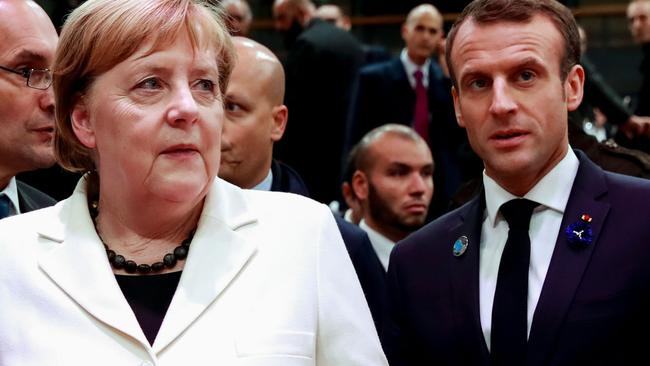Coronavirus: Prepare for next pandemic, Europe warned
Europe’s main leaders have admitted they fell short against the coronavirus and have urged countries to prepare for a potential second wave.

Europe’s main leaders have admitted they fell short against the coronavirus outbreak and have urged countries to prepare for a potential second wave.
Germany, France and four other countries said Europe’s chaotic response to the COVID-19 outbreak, in which 184,256 people have died, has “raised questions about the EU’s preparedness for pandemics”.
A letter by the leaders addressed to European Commission chief Ursula von der Leyen is the clearest attempt yet by the EU’s most powerful leaders to spur the bloc’s executive to fix the disunity displayed in the crisis, especially in its earliest days.
“We hope that the paper can serve as an inspiration for fruitful, further discussions at European level on how to ensure the EU’s preparedness for future pandemics,” the leaders say.
As the global outbreak first took hold, member states looked inward, shutting borders, hoarding medical supplies and waving through major spending plans regardless of EU rules.
The letter to Ms von der Leyen was signed by French President Emmanuel Macron, Germany’s Angela Merkel, Mateusz Morawiecki of Poland, Spanish Prime Minister Pedro Sanchez, Belgium’s Sophie Wilmes and Mette Frederiksen of Denmark.
The letter put a special emphasis on the shortages of desperately needed medical supplies that were felt unevenly as the virus made its way across the continent.
“Understanding the shortcomings is essential,” the policy paper insisted. “These include a sufficient supply of personal protective equipment, medical devices, critical medicines, and vaccines.”
The leaders also pressed Brussels to streamline data across the bloc so that rates of infection and other key figures matched from one country to the other.
The 27 leaders of the EU will hold virtual talks next Friday to discuss the fallout of the crisis.
The letter comes as most of the continent eases restrictions, despite growing numbers of COVID-19 cases across the world.
The sudden easing of strict lockdown rules in Moscow has made Kremlin critics suspicious, especially after the city registered more than 3500 new cases and 110 deaths on Monday and Tuesday.
All limits on movement were abruptly scrapped on Tuesday, while courts and hairdressers were allowed to reopen.
Cafes and restaurants will welcome visitors from next week.
Sergei Sobyanin, the mayor and the head of Russia’s virus taskforce, had previously warned that normal life would not return until a vaccine had been found. Instead, he congratulated Muscovites “on another shared victory”.
Since the country’s suspected patient zero arrived in Moscow from Milan in February, the health ministry has confirmed more than 485,000 cases, the third-highest in the world after the US and Brazil.
Yet despite the huge number of infections, Russia says only 6142 people have been killed by the virus, a fatality rate barely above 1 per cent, far below the global average of about 6 per cent.
In Britain, the government abandoned plans to have all primary school children return to the classroom in England before the mid-year summer holidays after schools voiced worries about their ability to meet coronavirus social distancing requirements.
Education Secretary Gavin Williamson admitted that the goal for England’s five million primary schoolchildren from age four to 11 wasn’t possible, given constraints related to classroom sizes, the need for social distancing and inadequate numbers of teachers.
Experts are also worried that a further surge of the coronavirus in under-developed regions with shaky health systems could undermine efforts to halt the pandemic.
Britain has seen the deadliest coronavirus outbreak in Europe, with nearly 40,900 confirmed deaths.
Brazil, Mexico, South Africa, India and Pakistan are among the countries easing lockdown restrictions before their outbreaks have peaked and without detailed surveillance and testing systems in place.
Meanwhile, the World Health Organisation says it isn’t clear how often people contract and then spread COVID-19 without showing symptoms, pulling back from a top official’s earlier assertion that such invisible transmission appears rare.
The clarification suggests that six months into the coronavirus pandemic, the UN agency and researchers lack clarity on what is a central riddle in how the respiratory disease circulates.
Estimates suggest at least 6 per cent — and as much as 41 per cent — of people who contract the disease don’t have symptoms, said WHO technical lead Maria Van Kerkhove. There is no medical consensus on how many of those individuals then infect somebody else. “That’s a big open question and that remains an open question,” she said. “It’s a new disease. We’re learning a lot about it.”
Her statement followed criticism from public health researchers of her remarks on Monday, when she said: “From the data we have, it still seems to be rare that an asymptomatic person actually transmits onward to a secondary individual.”
She now says she had been unclear, while saying her earlier assertion was based on privately conveyed data from governments she didn’t identify, as well as “two or three studies”.
AFP, AP, The Wall Street Journal



To join the conversation, please log in. Don't have an account? Register
Join the conversation, you are commenting as Logout